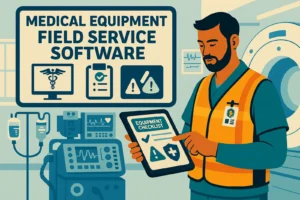Paper forms slow good people down. Requests get misread, notes go missing, and nobody can explain where the day went. A Work Order Tracking System flips that. Requests become structured tickets, approvals take seconds, and every job carries parts, time, photos, and signatures in one clean record. Dispatch can route with confidence, managers see real costs, and customers stop chasing updates.
You don’t need a long transformation to feel the difference. Start with one team, one KPI, and a simple set of rules. With Shifton you can test the core toolkit for a full month at no cost—publish digital work orders, run mobile checklists, capture proof, and see how much rework disappears.
Work Order Tracking System bottlenecks in handoffs and ETAs
When work lives across emails, chats, and clipboards, three things happen. Firstly, priorities drift; “urgent” depends on who shouts loudest. Secondly, approvals stall in inboxes. Thirdly, accounting fights for evidence at month-end. A Work Order Tracking System fixes this by giving everyone one place to submit, approve, do, and prove the work—fast and without drama.
What “good” looks like in practice
A practical Work Order Tracking System handles the entire loop:
Structured intake. Clear categories, required fields, photos, and due dates prevent back-and-forth.
Smart triage. Priority and risk rules surface safety issues and SLA commitments.
Skills-aware assignment. Jobs land on people certified for the task; backups are suggested.
Parts + time in one place. Required items are listed up front; time is job-locked with optional geofencing.
Mobile execution (offline). Checklists, photos, and signatures work without signal and sync later.
Audit-ready closeout. A simple report with steps, timestamps, materials, and approvals.
That loop turns chaotic days into a steady rhythm and gives you trustworthy data to plan the next one.
Where the minutes really go—and how the system gives them back
Missing info at intake. Unclear requests create half a dozen messages. Structured forms with a photo field fix it.
Slow approvals. Managers travel; email lags. One-tap approval in the app keeps work moving.
Parts surprises. A tech arrives empty-handed and promises to “come back tomorrow.” Required parts and nearest pickup solve that.
Note-taking at 7 p.m. End-of-day memory is unreliable. Capturing notes and photos on site makes disputes vanish.
Manual timecards. Hours rounded up by habit—because the process is painful. Job-locked, geofenced punches create clean, fair logs.
Each problem looks small. Together they crush throughput. A Work Order Tracking System removes them in one stroke.
The daily flow your team can follow
Submit. A requester picks a template, adds a short note and a photo.
Approve. Rules auto-approve low-risk tickets; others go to the right manager.
Plan. Dispatch assigns by skills and location, then chains jobs to protect windows.
Do. The tech follows a one-screen checklist, scans parts, snaps photos, and gets sign-off.
Close. Time, materials, and proof are already attached—billing can move the same day.
Review. Dashboards show travel minutes per job, repeats, SLA hits, and overtime.
Run that loop for two weeks and you’ll feel less firefighting and faster, calmer days.
Work Order Tracking System is your operations backbone: a single place where requests become approved jobs, approved jobs become clean records, and clean records become accurate invoices.
The benefits of Work Order Tracking System you can measure this month
Travel minutes per job: Down 15–25% with better chaining and fewer backtracks.
First-visit fix rate: Up 5–10% because skills and parts are matched up front.
On-time arrival / SLA hit rate: Up 2–5 points with proactive alerts and realistic windows.
Overtime: Down 10–15% as work evens out and approvals stop stalling.
Dispute rate: Way down—photos and signatures end most arguments in one email.
Features that actually move the needle
Routing that respects promises
Shortest path isn’t the goal—kept windows are. Your Work Order Tracking System should factor live traffic, job length, and break rules, then suggest the least-painful swap when a rush job lands. Customers get polite, automatic updates.
Skills + parts pairing
Tie each job type to certifications and a short parts list. Before wheels roll, the system verifies both—or shows the nearest pickup. That single guardrail slashes repeats.
Offline-first mobile work orders
Basements, mechanical rooms, remote sites—signal drops. The app must cache checklists, photos, and signatures and sync later without duplicates. If crews trust the app underground, they’ll use it.
Proof, not paperwork
Job-locked time, geofencing guardrails, photos, and signatures produce a one-page report customers understand and finance can bill immediately.
Analytics that trigger action
Dashboards must nudge behaviour, not decorate a wall. If travel minutes per job won’t drop, rebalance territories. If repeats spike on a task, fix the checklist or parts kit.
Rollout plan your crew will accept
Start with one KPI. Example: cut travel minutes per job by 15% in four weeks.
Clean only what matters. Top 20 job types, skills/cert expiry, addresses, parts lists.
Limit choices. Three intake templates, one report style, five core checklists.
Coach with data. Praise complete records before flagging gaps.
Scale on proof. Add more teams once the first team hits the KPI twice in a row.
Real examples by team size
Small crews (5–25). Biggest win is clean intake + quick approval. The day stops slipping because requests are clear and managers approve on the phone.
Mid-size (25–150). Routing and parts pairing matter most—miles fall and first-visit fixes rise.
Large orgs (150+). Consistent reports and SLA guardrails reduce credits and speed audits.
People first: privacy and trust
Track only on the job, inside geofences, visible to the worker. No after-hours tracking. Show the exact data you keep and let people correct obvious mistakes. When a Work Order Tracking System protects people’s time and reputation, adoption sticks.
Integrations (what you really need)
CRM/ERP. Customer and asset context flows in; invoices flow out.
Inventory. Parts reservations and van-stock rules stay accurate.
Email/SMS. Confirmation, on-the-way, and done messages send themselves.
SSO. Fewer passwords equals fewer access issues on Monday morning.
Work Order Tracking System fixes: SOPs, dashboards, surveys
Phone-first, works offline
Job-locked, geofenced time tracking
Skills + parts logic with expiry alerts
Routing that honours windows and traffic
One-tap approvals and simple overrides
Photo/signature proof baked in
Reports customers actually read
Open API for CRM, inventory, and finance
If a tool misses most of these, you’ll be back to spreadsheets the first busy week.
Objections you’ll hear—and straight answers
“We already track hours in payroll.” Totals aren’t enough. You need route-aware job time to fix zones, windows, and estimates; that’s what a Work Order Tracking System delivers.
“GPS feels invasive.” Track inside job geofences only; show people the data you store; let them correct mistakes. Respect builds trust.
“This will slow techs down.” One-tap punches and photo notes take seconds and save hours of back-and-forth later.
FAQ
What problems does a Work Order Tracking System solve first?
Lost info and slow approvals.
Structured intake prevents gaps, smart rules keep approvals moving, and mobile proof cuts disputes so jobs close faster.
How fast can we see results?
Two weeks.
Once intake, approvals, and mobile proof go live, miles drop, ETAs stabilise, and invoices move sooner. Gains compound as rules improve.
Will technicians lose flexibility?
No.
Use swap rules and approval flows so people can swap jobs when life happens while the system protects coverage and windows.
Do we need heavy IT to deploy?
Not really.
Import crews, skills, and job templates via CSV. Integrations can follow. A solid Work Order Tracking System works out of the box for a pilot.
How do we prove ROI?
Track four numbers.
Travel minutes per job, first-visit fix rate, SLA hit rate, and overtime hours. If these trend the right way, your licence pays for itself. Ready to swap paper chaos for clean control? Spin up a workspace, digitise intake, and run a two-week pilot. Core features are free for the first month—prove gains on live work, not slides.

 English (US)
English (US)  English (GB)
English (GB)  English (CA)
English (CA)  English (AU)
English (AU)  English (NZ)
English (NZ)  English (ZA)
English (ZA)  Español (ES)
Español (ES)  Español (MX)
Español (MX)  Español (AR)
Español (AR)  Português (BR)
Português (BR)  Português (PT)
Português (PT)  Deutsch (DE)
Deutsch (DE)  Deutsch (AT)
Deutsch (AT)  Français (FR)
Français (FR)  Français (BE)
Français (BE)  Français (CA)
Français (CA)  Italiano
Italiano  日本語
日本語  中文
中文  हिन्दी
हिन्दी  עברית
עברית  العربية
العربية  한국어
한국어  Nederlands
Nederlands  Polski
Polski  Türkçe
Türkçe  Українська
Українська  Русский
Русский  Magyar
Magyar  Română
Română  Čeština
Čeština  Български
Български  Ελληνικά
Ελληνικά  Svenska
Svenska  Dansk
Dansk  Norsk
Norsk  Suomi
Suomi  Bahasa
Bahasa  Tiếng Việt
Tiếng Việt  Tagalog
Tagalog  ไทย
ไทย  Latviešu
Latviešu  Lietuvių
Lietuvių  Eesti
Eesti  Slovenčina
Slovenčina  Slovenščina
Slovenščina  Hrvatski
Hrvatski  Македонски
Македонски  Қазақ
Қазақ  Azərbaycan
Azərbaycan  বাংলা
বাংলা 

